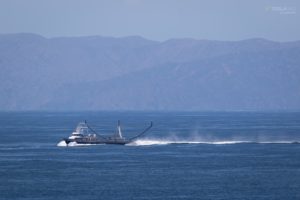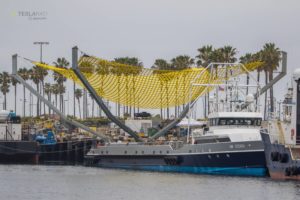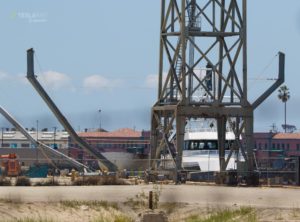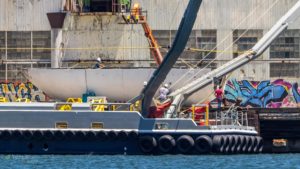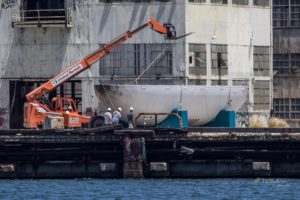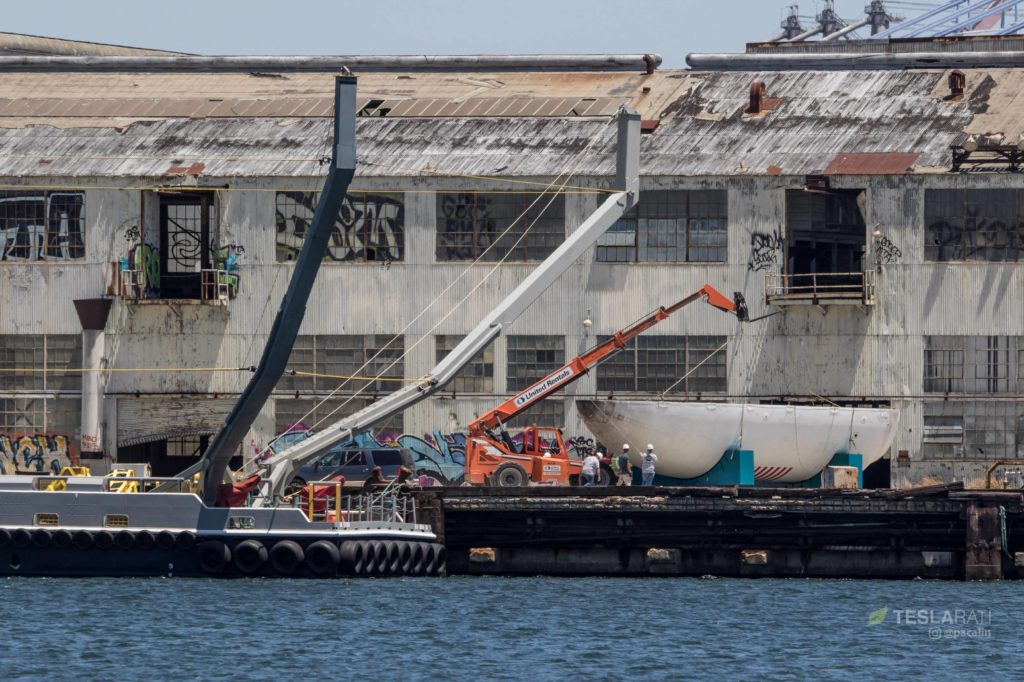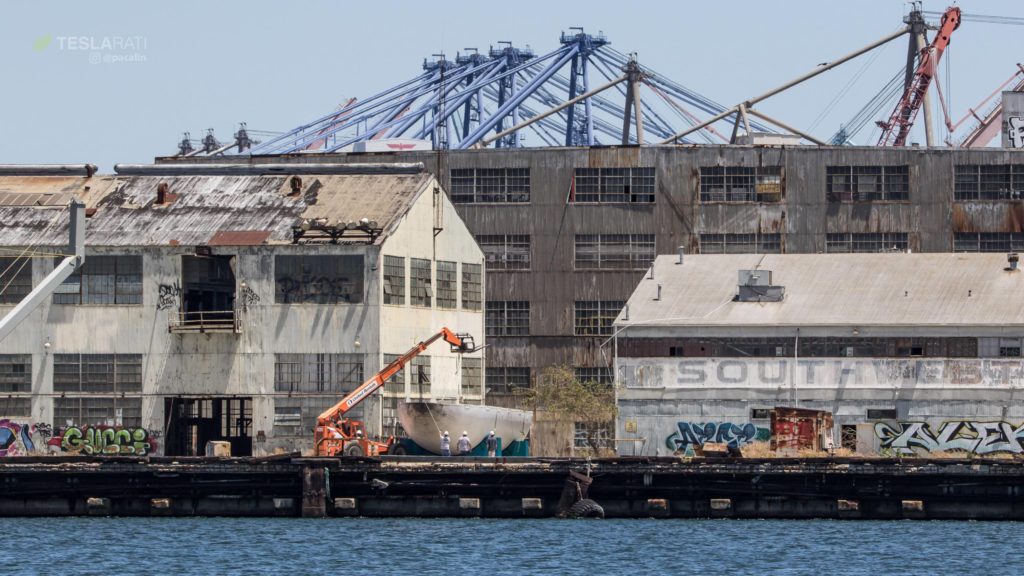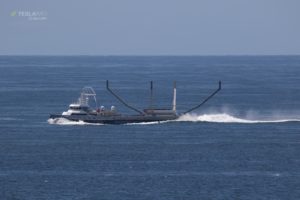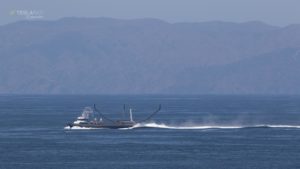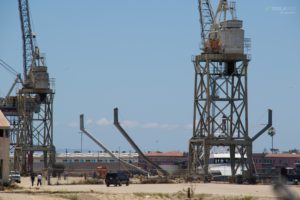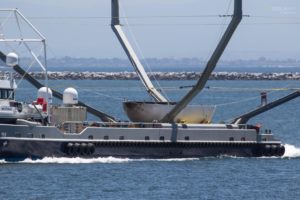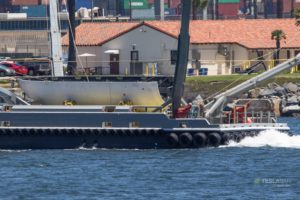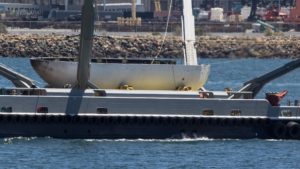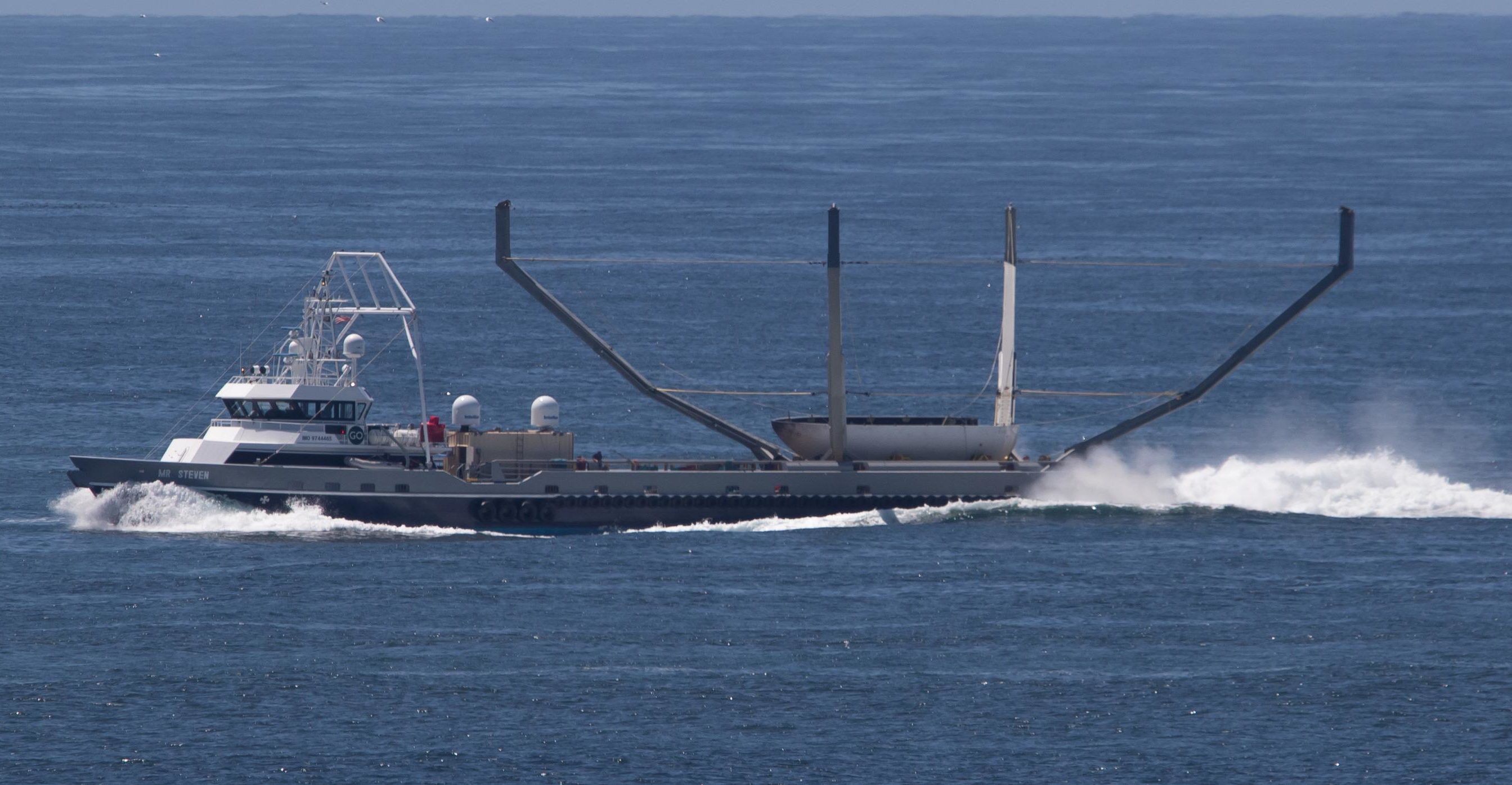

SpaceX
SpaceX rocket fairing reappears on Mr Steven after six week hiatus
A hop and a skip away from SpaceX’s first Falcon 9 Block 5 recovery, the company’s famous fairing recovery vessel Mr Steven was caught by Teslarati photographer Pauline Acalin performing some unusual maneuvers at sea, hauling what can only have been the intact fairing half recovered after SpaceX’s March 30 launch of Iridium NEXT-5.
Why exactly the fairing half was aboard Mr Steven for high-speed trials and eventual delivery to Berth 240 – SpaceX’s future Mars rocket factory – is not entirely clear. The most obvious explanation is that these new operations are in some way related to Falcon 9 payload fairing drop tests hinted at recently by CEO Elon Musk, tests that would allow the company to hone the accuracy of the autonomous parafoils currently used to recover them. In light of Mr Steven’s newly upgraded net, the goal is to gently catch each fairing before they touch down on the ocean’s surface – per SpaceX’s Hans Koenigsmann, even partial immersion in seawater precludes any future attempts at reuse.

SpaceX technicians offload the Iridium fairing half from Mr Steven while docked at Berth 240, SpaceX’s BFR (Mars rocket) factory in-waiting. (Pauline Acalin)
While we originally speculated that water intrusion into the fairing halves’ aluminum honeycomb composite structures – a common failure mode in the history of the material’s use in aerospace – would pose a problem for fairing reuse sans net capture, the actual reason Koenigsmann gave was the fact that the environment inside Falcon fairings must be kept extraordinarily clean to avoid damaging the highly sensitive satellite and spacecraft payloads housed inside. In retrospect, it makes a whole lot of sense that cleaning a fairing thoroughly enough after exposure to seawater/sea spray and its multitudes of organic material, minerals, and simple saltwater could pose an extremely expensive (if not outright intractable) problem for routine reusability. Hence Mr Steven and his wonderfully analog recovery hardware (i.e. a giant net).
- Fairing aboard, Mr Steven performed rapid turns and high-speed sprints with the fairing half aboard. (Pauline Acalin)
- Mr Steven and his fancy net 2.0, caught on May 7. Bright yellow…for style. (Pauline Acalin)
- On May 16, he arrived at Berth 240 with fairing half in tow. (Pauline Acalin)
- Note the distinctive yellow netting draped over the fairing stand aboard Mr Steven. It’s unclear if this is actually the new yellow net spotted last week, or if it’s actually webbing dedicated to securing the fairing cradle. (Pauline Acalin)
- It’s unclear why the Iridium fairing has been brought once again to Berth 240, aside perhaps from temporary storage. (Pauline Acalin)
After approximately six weeks of rest after its return to Port of San Pedro aboard Mr Steven, the fairing half found itself speeding around the mouth of Port of San Pedro aboard the net boat Mr Steven on May 16, after which it was carefully offloaded at SpaceX’s recently-leased Berth 240 facilities, set to one day become the company’s first Mars rocket and spaceship factory (currently housed in a giant tent a few miles away).
A careful scan of the day’s aviation activities showed no tracked helicopter flights that could have been involved in fairing drop tests, and it’s equally implausible that SpaceX would choose (or be permitted) to attempt to catch a 1000 kg autonomous parafoil a handful of miles from densely populated Los Angeles. Mr Steven’s distinctive yellow net – a brand new upgrade – was also visibly strewn about the vessel’s deck, over top of a basic wooden fairing stand, atop of which sat the sooty Iridium fairing half. Given the lengthy journey, it has made to be aboard Mr Steven, May 16’s unusual day of testing is presumably just the beginning of a number of outings, perhaps culminating in fairing drop and catch tests with a helicopter.
- Regardless of why it’s there, the contrast of the dilapidated urban landscape and cutting-edge flight-proven rocket hardware is absolutely breathtaking.(Pauline Acalin)
- Jump maybe 6 months ahead, and one can already begin to imagine that the first BFS test article may end up being craned aboard a barge before the exact same backdrop. (Pauline Acalin)
Regardless, the whole event was an incredible spectacle, caught in awesome detail by Pauline Acalin. One can only begin to imagine what other sights might one day – perhaps fairly soon – grace the dramatic dockside space SpaceX now owns at Berth 240.
- It’s difficult to imagine how Mr Steven’s already vast net could plausibly be expanded by a factor of two in each dimension. I certainly can’t wait to see how SpaceX engineers and technicians tackle the task. (Pauline Acalin)
- Fairing aboard, Mr Steven performed rapid turns and high-speed sprints with the fairing half aboard. (Pauline Acalin)
- Mr Steven and the Iridium fairing half berthed at SpaceX’s Berth 240. (Pauline Acalin)
- Mr Steven returns to port with the Iridium fairing half aboard. (Pauline Acalin)
- Mr Steven out and about with a recovered but unreusable fairing half in May 2018, presumably for some sort of practice. (Pauline Acalin)
- Mr Steven returns to port with the Iridium fairing half aboard. (Pauline Acalin)
Follow us for live updates, behind-the-scenes sneak peeks, and a sea of beautiful photos from our East and West coast photographers.
Teslarati – Instagram – Twitter
Tom Cross – Twitter
Pauline Acalin – Twitter
Eric Ralph – Twitter
News
SpaceX launches Ax-4 mission to the ISS with international crew
The SpaceX Falcon 9 launched Axiom’s Ax-4 mission to ISS. Ax-4 crew will conduct 60+ science experiments during a 14-day stay on the ISS.
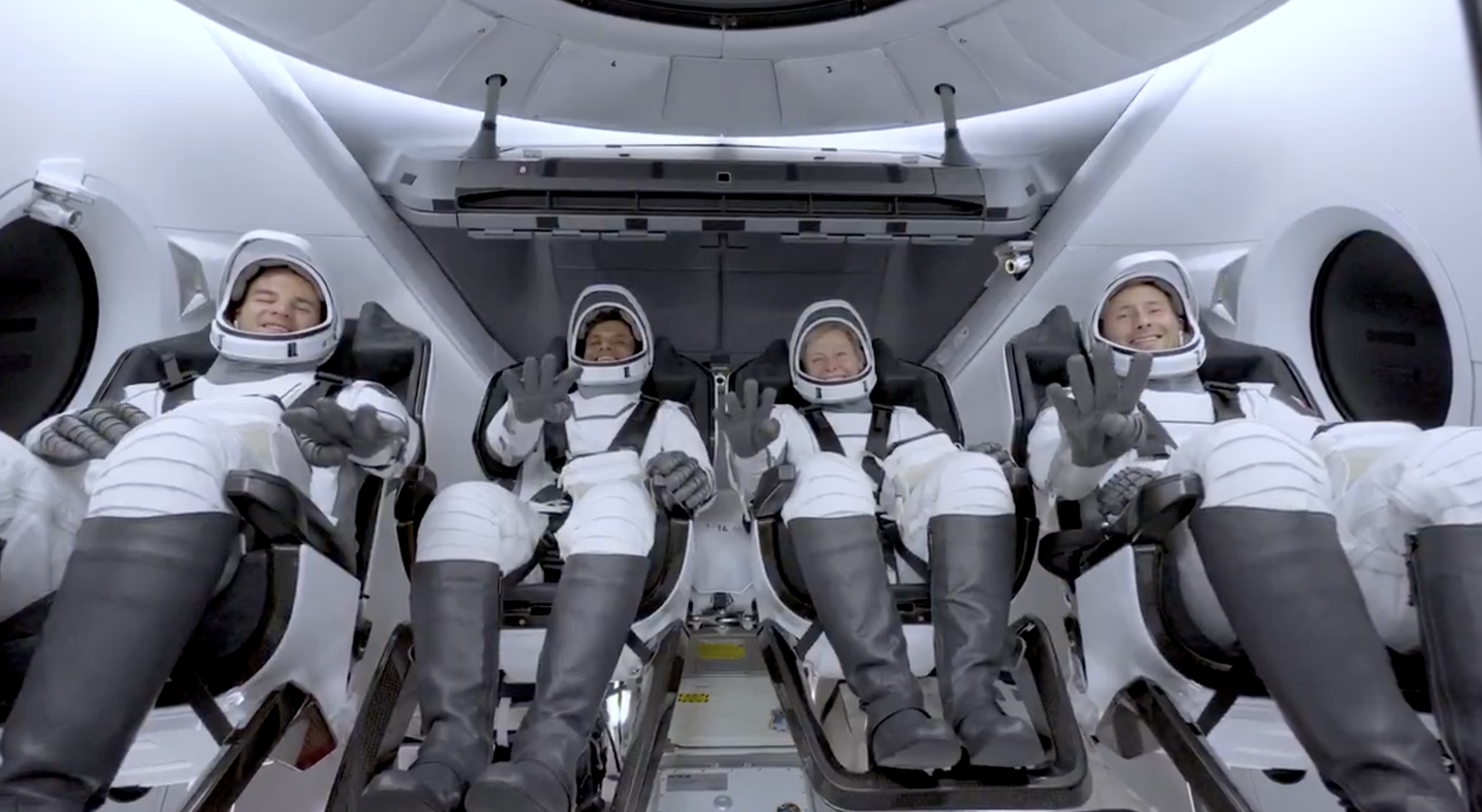
SpaceX launched the Falcon 9 rocket kickstarting Axiom Space’s Ax-4 mission to the International Space Station (ISS). Axiom’s Ax-4 mission is led by a historic international crew and lifted off from Kennedy Space Center’s Launch Complex 39A at 2:31 a.m. ET on June 25, 2025.
The Ax-4 crew is set to dock with the ISS around 7 a.m. ET on Thursday, June 26, 2025. Axiom Space, a Houston-based commercial space company, coordinated the mission with SpaceX for transportation and NASA for ISS access, with support from the European Space Agency and the astronauts’ governments.
The Ax-4 mission marks a milestone in global space collaboration. The Ax-4 crew, commanded by U.S. astronaut Peggy Whitson, includes Shubhanshu Shukla from India as the pilot, alongside mission specialists Sławosz Uznański-Wiśniewski from Poland and Tibor Kapu from Hungary.
“The trip marks the return to human spaceflight for those countries — their first government-sponsored flights in more than 40 years,” Axiom noted.
Shukla’s participation aligns with India’s Gaganyaan program planned for 2027. He is the first Indian astronaut to visit the ISS since Rakesh Sharma in 1984.
Axiom’s Ax-4 mission marks SpaceX’s 18th human spaceflight. The mission employs a Crew Dragon capsule atop a Falcon 9 rocket, designed with a launch escape system and “two-fault tolerant” for enhanced safety. The Axiom mission faced a few delays due to weather, a Falcon 9 leak, and an ISS Zvezda module leak investigation by NASA and Roscosmos before the recent successful launch.
As the crew prepares to execute its scientific objectives, SpaceX’s Ax-4 mission paves the way for a new era of inclusive space research, inspiring future generations and solidifying collaborative ties in the cosmos. During the Ax-4 crew’s 14-day stay in the ISS, the astronauts will conduct nearly 60 experiments.
“We’ll be conducting research that spans biology, material, and physical sciences as well as technology demonstrations,” said Whitson. “We’ll also be engaging with students around the world, sharing our experience and inspiring the next generation of explorers.”
SpaceX’s Ax-4 mission highlights Axiom’s role in advancing commercial spaceflight and fostering international partnerships. The mission strengthens global space exploration efforts by enabling historic spaceflight returns for India, Poland, and Hungary.
News
Starlink Cellular’s T-Mobile service to grow with third-party app data
From Oct 2025, T-Satellite will enable third-party apps in dead zones! WhatsApp, X, AccuWeather + more coming soon.
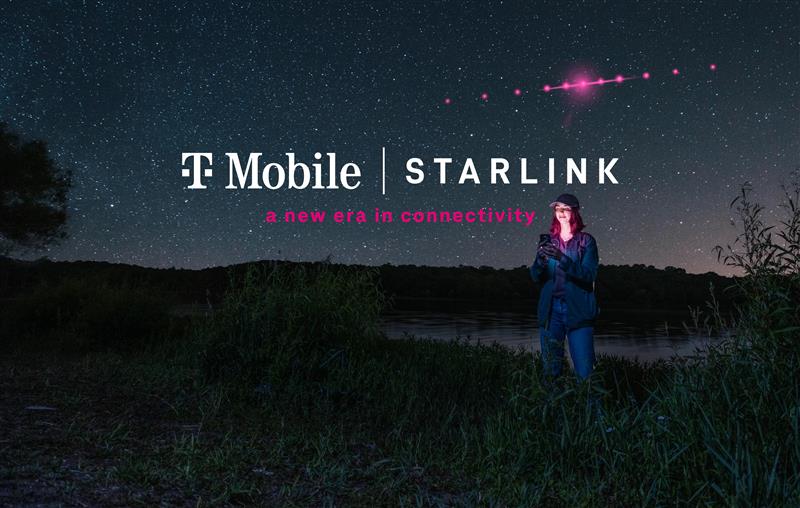
Starlink Cellular’s T-Mobile service will expand with third-party app data support starting in October, enhancing connectivity in cellular dead zones.
T-Mobile’s T-Satellite, supported by Starlink, launches officially on July 23. Following its launch, T-Mobile’s Starlink Cellular service will enable data access for third-party apps like WhatsApp, X, Google, Apple, AccuWeather, and AllTrails on October 1, 2025.
T-Mobile’s Starlink Cellular is currently in free beta. T-Satellite will add MMS support for Android phones on July 23, with iPhone support to follow. MMS support allows users to send images and audio clips alongside texts. By October, T-Mobile will extend emergency texting to all mobile users with compatible phones, beyond just T-Mobile customers, building on its existing 911 texting capability. The carrier also provides developer tools to help app makers integrate their software with T-Satellite’s data service, with plans to grow the supported app list.
T-Mobile announced these updates during an event celebrating an Ookla award naming it the best U.S. phone network, a remarkable turnaround from its last-place ranking a decade ago.
“We not only dream about going from worst to best, we actually do it. We’re a good two years ahead of Verizon and AT&T, and I believe that lead is going to grow,” said T-Mobile’s Chief Operating Officer Srini Gopalan.
T-Mobile unveiled two promotions for its Starlink Cellular services to attract new subscribers. A free DoorDash DashPass membership, valued at $10/month, will be included with popular plans like Experience Beyond and Experience More, offering reduced delivery and service fees. Meanwhile, the Easy Upgrade promotion targets Verizon customers by paying off their phone balances and providing flagship devices like the iPhone 16, Galaxy S25, or Pixel 9.
T-Mobile’s collaboration with SpaceX’s Starlink Cellular leverages orbiting satellites to deliver connectivity where traditional networks fail, particularly in remote areas. Supporting third-party apps underscores T-Mobile’s commitment to enhancing user experiences through innovative partnerships. As T-Satellite’s capabilities grow, including broader app integration and emergency access, T-Mobile is poised to strengthen its lead in the U.S. wireless market.
By combining Starlink’s satellite technology with strategic promotions, T-Mobile is redefining mobile connectivity. The upcoming third-party app data support and official T-Satellite launch mark a significant step toward seamless communication, positioning T-Mobile as a trailblazer in next-generation wireless services.
News
Starlink expansion into Vietnam targets the healthcare sector
Starlink aims to deliver reliable internet to Vietnam’s remote clinics, enabling telehealth and data sharing.

SpaceX’s Starlink expansion into Vietnam targets its healthcare sector. Through Starlink, SpaceX seeks to drive digital transformation in Vietnam.
On June 18, a SpaceX delegation met with Vietnam’s Ministry of Health (MoH) in Hanoi. SpaceX’s delegation was led by Andrew Matlock, Director of Enterprise Sales, and the discussions focused on enhancing connectivity for hospitals and clinics in Vietnam’s remote areas.
Deputy Minister of Health (MoH) Tran Van Thuan emphasized collaboration between SpaceX and Vietnam. Tran stated: “SpaceX should cooperate with the MoH to ensure all hospitals and clinics in remote areas are connected to the StarLink satellite system and share information, plans, and the issues discussed by members of the MoH. The ministry is also ready to provide information and send staff to work with the corporation.”
The MoH assigned its Department of Science, Technology, and Training to work with SpaceX. Starlink Vietnam will also receive support from Vietnam’s Department of International Cooperation. Starlink Vietnam’s agenda includes improving internet connectivity for remote healthcare facilities, developing digital infrastructure for health examinations and remote consultations, and enhancing operational systems.
Vietnam’s health sector is prioritizing IT and digital transformation, focusing on electronic health records, data centers, and remote medical services. However, challenges persist in deploying IT solutions in remote regions, prompting Vietnam to seek partnerships like SpaceX’s.
SpaceX’s Starlink has a proven track record in healthcare. In Rwanda, its services supported 40 health centers, earning praise for improving operations. Similarly, Starlink enabled remote consultations at the UAE’s Emirati field hospital in Gaza, streamlining communication for complex medical cases. These successes highlight Starlink’s potential to transform Vietnam’s healthcare landscape.
On May 20, SpaceX met with Vietnam’s Ministry of Industry and Trade, announcing a $1.5 billion investment to provide broadband internet, particularly in remote, border, and island areas. The first phase includes building 10-15 ground stations across the country. This infrastructure will support Starlink’s healthcare initiatives by ensuring reliable connectivity.
Starlink’s expansion in Vietnam aligns with the country’s push for digital transformation, as outlined by the MoH. By leveraging its satellite internet expertise, SpaceX aims to bridge connectivity gaps, enabling advanced healthcare services in underserved regions. This collaboration could redefine Vietnam’s healthcare infrastructure, positioning Starlink as a key player in the nation’s digital future.
-

 Elon Musk4 days ago
Elon Musk4 days agoTesla investors will be shocked by Jim Cramer’s latest assessment
-

 News1 week ago
News1 week agoTesla Robotaxi’s biggest challenge seems to be this one thing
-

 Elon Musk2 weeks ago
Elon Musk2 weeks agoFirst Look at Tesla’s Robotaxi App: features, design, and more
-

 News2 weeks ago
News2 weeks agoSpaceX and Elon Musk share insights on Starship Ship 36’s RUD
-

 News2 weeks ago
News2 weeks agoWatch Tesla’s first driverless public Robotaxi rides in Texas
-

 News1 week ago
News1 week agoWatch the first true Tesla Robotaxi intervention by safety monitor
-

 News2 weeks ago
News2 weeks agoTesla has started rolling out initial round of Robotaxi invites
-

 Elon Musk2 weeks ago
Elon Musk2 weeks agoTesla to launch in India in July with vehicles already arriving: report

